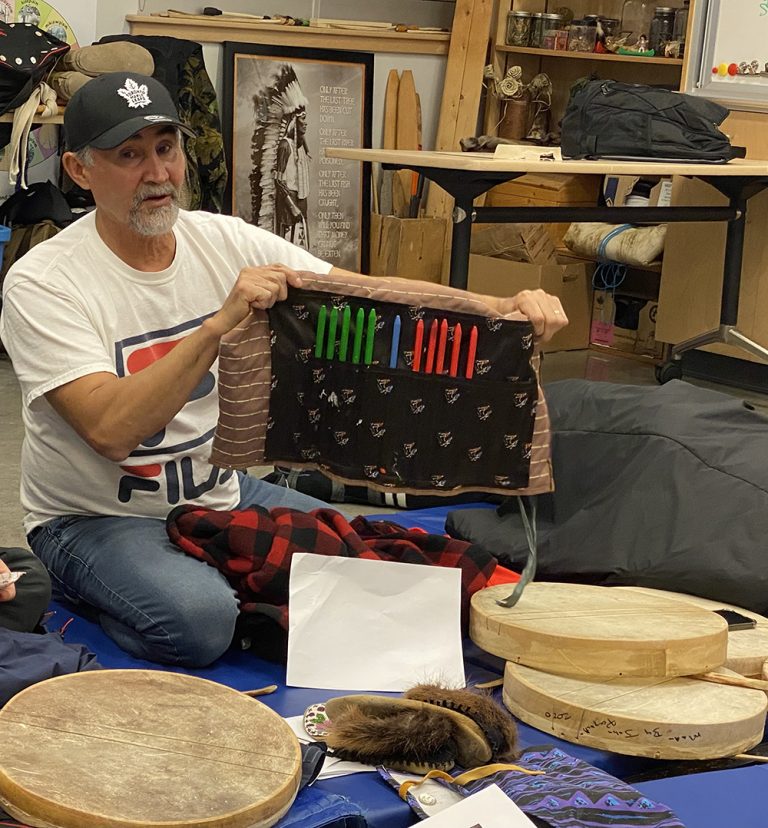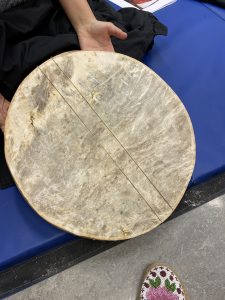
Valerie G. Barnes Connell Jordan
Northern Advocate
Dene Hand Games involves the history, purpose, culture, language and hands on playing of drums, and thanks to Elder John Pacquette, it’s the focus of the Northern Lifestyles class for students in Churchill Community High School (CCHS).
The class also covers trapping, being on the land and travelling by snow machine to the trapline, as they relate to Dene culture.
Students have that opportunity thanks to Elder John Pacquette, who travels for one week monthly throughout the school year, to work with the students exploring Dene culture. The games, drumming, getting on the land, trapping beaver and travelling by snow machine rate tops with students.
“I like learning the different reasons why they do certain things: like, why they [the traps] are set a different way?,” student Riel Runningaround said. “Why they are put in a certain spot? So, you know which way it’s done, and you don’t have to have messed up trapping in your face.”
The Saskatchewan Arts Board funds and supports the program, which involves Pacquette spending one week every month throughout the school year, with the exception of April, to work with the students, Christine Revenis, northern Lifestyles teacher said.
“I gave you the month off,” she said to Paquette in the interview with the Northern Advocate referring to the April break in their schedule.
The Saskatchewan Arts Board provides support and funding for the program, Ravenis said.
The hand games are the best part of the program, according to Kenny Sanderson, one of the students.
“Being in her [Ravenis] class,’ is a highlight for Honey Ballantyne, also a student.
For Joseph Cook, “I enjoy the snow machine rides,” he said. “Tomorrow we’re going to pull out our beaver snares.”
Participating in the Hand Games is the highlight for student Osman Bear.
“I noticed the people in this class who have the opportunity at the bush to set traps,” student Tristen Charles said, referring to a highlight of the class for himself. Dene traps are a “different kind of trap [used] for different animals,” he said.
“And we learn the Dene words to go with it,” Ravenis added, referring to the language component of the sessions.
The class began in October with the making two or three drums, which involved cutting down a tamarack tree to make the drum frames.
Because it was Paquette’s first trip to the area and he was unfamiliar with the roads, it took three-and-a-half hours to find and cut up the tree needed for the drum frames.

Because it was Paquette’s first trip to the area and he was unfamiliar with the roads, it took three-and-a-half hours to find and cut up the tree needed for the drum frams.
They made the rims, clamped them and left them to take shape.
They then cleaned and scraped caribou skins for the drum covers.
Because he travels six or seven hours north from his home into the Northwest Territories to hunt for Caribou, “maybe about three days by snow machine,” Pacquette brought the Caribou skins for the drums with him.
“You have to be careful when you make a drum … they’re large. They cover the caribou hide and then it won’t break,” he said referring to sinew string used to tighten the hide to the rim, securely, but not too tight, and make the handle on the underside. They also run sinew string across the top of the drum, and that is what makes the unique sound of the Dene drum.
Drumsticks are made with willow.
The drum has not allowed or used in Dene culture in more than 100 years, “So, we’re bringing it back,” Pacquette said.
The Hand Games are a social event in the community, he said.
“Today the Hand Games is played in cultural centres, communities, carnivals and other events all over the Dene country as a friendly competition fostering community pride.”
The games are based on a simple concept using elaborate hand symbols and gestures to support each game. These symbols and gestures change according to regions, which can be confusing for players in a competition. Two teams kneel opposite each other and members of the one team hide tokens. A member of the opposite team tries to guess where they are. The caller in the game uses hand signals to communicate with other teams.
“We challenge each other.”
A set of 12 sticks, is used for counting. The sticks, made of willow and are changed every days of a competition. They are often made in different styles depending on the region the players represent, Pacquette also said.
A game may take three to four days to complete, with breaks after five to six hours. The games continue throughout the night as well.
Students enthusiastically learn about the games along with the language and drumming that accompanies the games.
An important part of the games, the teachings. “There is always teachings,” Pacquette said.
Because he travelled by himself to La Ronge this trip, he was not been able to begin incorporating the teachings that pertain to the games on this trip, but he hopes to have other drummers come with him on future times, allowing him time and resources to facilitate the teachings.
The games are always accompanied by drumming, singing and dancing.
Learning the singing and dance will be part of future classes, Ravenis said.
